Engineered wood flooring comprises a high-strength core (typically plywood and sometimes oriented strand board) and a thick natural wood veneer.
It may be repeatedly sanded and polished. But its durability falls short of that of real hardwood.
Cost
Engineered hardwood flooring is a more affordable alternative to solid hardwood. This flooring style is available in many types and species and can be installed in almost any room of your home.
Its construction is also more dimensionally stable than solid wood. The layers of wood in engineered floors are positioned in different directions, which helps the floor resist warping and shrinking.
It makes it a good choice for basement installations or other areas where humidity and moisture may be a concern. It also prevents warping and splitting because of temperature variations in your home.
Engineered floors from Soen Hardwood are easier to install than their solid counterparts, and most come prefinished and ready to be laid. They can be nailed, stapled, or (the most accessible option) attached with a click-and-lock system that snaps together like puzzle pieces.
Durability
Engineered hardwood flooring is an excellent choice for homeowners who want a hardwood floor that can endure everyday use and abuse. It also offers many options and design features that aren’t available with solid wood, including softer exotic species, specialty textures, color effects, extra-wide planks, and more.
Moreover, engineered floors can be installed in various environments that solid hardwood cannot. They’re perfect for installing over radiant floor heating, concrete slabs, and basement floors.
However, a few disadvantages do come with engineered flooring. First, it may be more susceptible to moisture issues than solid hardwood.
Maintenance
Engineered hardwood flooring requires very little maintenance to keep it looking pristine. However, it does require routine cleaning.
The best way to keep your engineered hardwood floors clean and clear of dirt and debris is to sweep them daily. Keeping them clean will also help you avoid scratches and scuff marks that may appear over time, requiring more intense repair or refinishing.
When you need to clean your engineered hardwood, use a cleaning product specifically made for wood flooring. Avoid harsh chemicals like ammonia, bleach, or oil soaps, as they can dull the floor’s finish and make it more susceptible to scratching.
Excessive water is another cause of damage to engineered wood flooring. Spills have to be cleaned up right away.
Installation
Engineered hardwood flooring is a durable and eco-friendly alternative to traditional hardwood floors. It features a thick natural wood veneer covered by multiple layers of plywood or fiberboard.
Engineered floors are an excellent choice for homeowners who want to get the look of hardwood flooring without paying the price tag. They’re also more resistant to seasonal changes in temperature and humidity, which can cause other types of flooring to warp.
Installing engineered flooring is a relatively simple process. It can be installed at any grade level and over most subfloor surfaces.
Depending on the type of installation you choose, you’ll need to perform different steps before starting.
Before installing any floor, it’s essential to ensure your subfloor is ready for it. Assess the surface, scrape it clean, and prepare it for repairs.
Related Articles:-










